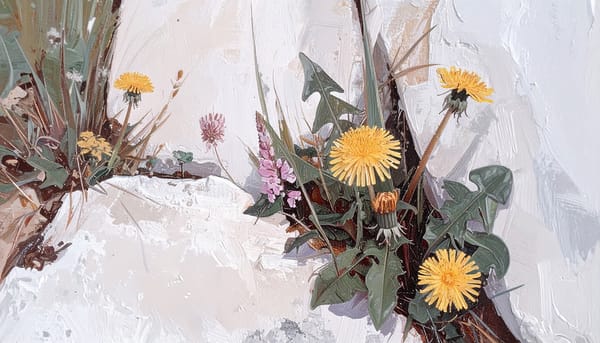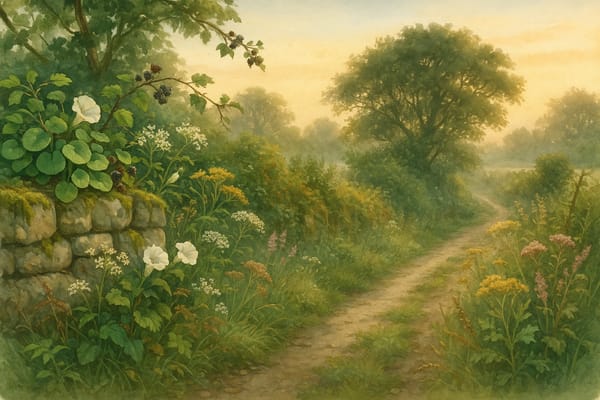In every crack of the pavement, border of a flowerbed, or corner of a vegetable patch, a so-called "weed" finds its place. For generations, gardeners have pulled, hoed, and sprayed in an endless battle against these persistent plants. But are weeds simply a blight — or are they undervalued allies in the natural world?
The truth lies somewhere in between. Many weeds offer surprising ecological benefits, from pollinator support to soil health, while others, particularly invasive species, threaten native biodiversity and ecosystem stability. Understanding both sides of this story invites a richer, more balanced approach to gardening and land care.
Wild Beauties: Celebrating Herb Robert, Dandelions, and Other Native "Weeds"
Some of the plants most often dismissed as weeds are, in fact, native wildflowers with rich ecological roles and unexpected charm.
Herb Robert (Geranium robertianum)
- Visual Appeal: With its lacy, red-tinged foliage and delicate pink flowers, herb robert brightens shady garden spots and woodland edges. Its reddish stems and aromatic leaves add character across the seasons.
- Ecological Benefits: A long flowering period from spring to autumn provides nectar for bees and hoverflies. Its adaptability to sun or shade and low-maintenance nature make it a valuable component of wildlife-friendly gardens.
- Cultural Use: Historically used in herbal medicine and known for its mosquito-repelling scent.
Dandelion (Taraxacum officinale)
- Beauty in Bloom: Cheerful yellow flowers in early spring lift spirits and invite pollinators. The iconic seed heads are a symbol of nature’s resilience and childhood wonder.
- Soil Engineer: Deep taproots aerate compacted soils, draw up nutrients from subsoil, and enhance fertility upon decomposition. Dandelions improve drainage, reduce erosion, and serve as natural nutrient recyclers.
- Wildlife Support: A vital nectar source for early pollinators, habitat for insect larvae, and food for birds and mammals.
The Hidden Functions of Weeds in Gardens and Ecosystems
| Wild Plant | Beauty Traits | Ecological Benefits |
|---|
| Herb Robert | Pink flowers, aromatic red foliage | Pollinator food, native support, low maintenance |
| Dandelion | Bright blooms, iconic seed heads | Soil health, erosion control, pollinator hub |
Weeds like these enrich garden biodiversity, often outperforming ornamental plants in supporting wildlife. They stabilize soil, enhance microbial life, and require little care — offering natural resilience in changing climates.
The Protective Role of Weeds in Soil Health and Erosion Control
Weeds don’t just survive poor conditions — they heal them.
- Compaction Breakers: Deep-rooted weeds like dandelions and docks penetrate hardpan soils, creating pathways for air, water, and root growth.
- Soil Stabilizers: Fibrous-rooted plants like nettles, buttercups, and couch grass bind soil against erosion by wind and water.
- Living Mulch: Fast-growing species like chickweed protect soil from raindrop impact, conserve moisture, and prevent crusting.
- Natural Rejuvenators: As pioneer species, weeds are often the first to colonize disturbed ground, making way for long-term vegetation recovery.
| Weed Species | Root Type | Soil Benefit |
|---|
| Rushes (Juncus spp.) | Dense fibrous | Stabilize wet soils |
| Dock (Rumex spp.) | Deep taproot | Break compaction, hold slopes |
| Gorse/Broom | Woody, spreading | Stabilize sandy soils |
| Nettle (Urtica dioica) | Dense fibrous | Bind soil on banks and margins |
| Chickweed (Stellaria media) | Shallow, mat-forming | Rapid cover on disturbed ground |
The Ecological Insurance of Weed Diversity
Weeds support life at every trophic level — from pollinators and herbivorous insects to birds and mammals. Their biodiversity benefits include:
- Pollinator Support: Many weeds outperform ornamental flowers in nectar production.
- Food Chain Links: Weeds host herbivorous insects that feed birds, bats, and small mammals.
- Soil Builders: Their decomposition cycles nutrients, supporting soil organisms and reducing the need for fertilizers.
- Ecosystem Resilience: Diverse weed communities buffer ecosystems against pests, diseases, and environmental change.
However, balance is crucial. While a healthy diversity of native weeds can enhance garden ecosystems, unchecked weed dominance in agricultural or sensitive habitats can disrupt intended plantings.
The Dark Side of Weeds: Invasive Species and Ecological Disruption
Not all weeds are harmless — and some can be highly destructive to biodiversity.
The Threat of Invasive Weeds:
- Outcompete native flora, reducing biodiversity.
- Alter natural processes like nutrient cycling, water flow, and fire regimes.
- Degrade habitats, disrupt food webs, and threaten endangered species.
| Impact Area | Long-Term Effect of Invasive Weeds |
|---|
| Biodiversity | Reduced diversity, loss of rare species |
| Food Webs | Disrupted insect and animal populations |
| Ecosystem Processes | Altered nutrient cycles, hydrology |
| Resilience | Lower resistance to future invasions |
| Economic Costs | Increased management and restoration expense |
Invasive weeds like Japanese knotweed, Himalayan balsam, and giant hogweed exemplify how unchecked spread can cause lasting damage to landscapes and ecosystems.
Managing Weeds Wisely: Balance, Conservation, and Control
A balanced approach is essential:
- Encourage Native "Weeds": Allow beneficial natives like herb robert and dandelions to grow in selected areas.
- Prevent Invasives: Monitor for invasive species and act quickly using integrated control methods.
- Restore with Native Plants: After invasive removal, plant competitive native species to suppress regrowth and enhance resilience.
- Rotational Management: Control weed populations through selective mowing, grazing, or trimming to maintain biodiversity without losing critical habitats.
| Management Approach | Best Use |
|---|
| Prevention | Biosecurity, public awareness |
| Early Detection | Citizen science, rapid response |
| Integrated Control | Mechanical, chemical, biological |
| Native Plant Restoration | Post-removal rewilding |
Rethinking the Role of Weeds in Our Gardens and Landscapes
Weeds challenge our idea of what belongs in a garden. They can be pioneers of soil health, champions of biodiversity, and key players in ecosystem resilience. Yet they can also be invasive disruptors requiring vigilant management.
By embracing native wild plants, allowing diversity in our landscapes, and managing invasives responsibly, we move beyond the simplistic "good plant/bad plant" mindset. We build richer gardens, healthier soils, and stronger ecosystems — and perhaps rediscover the humble beauty of a dandelion glowing in spring light or a clump of herb robert softening a stone wall.











